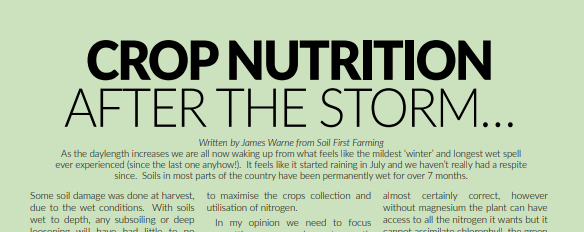As the daylength increases we are all now waking up from what feels like the mildest ‘winter’ and longest wet spell ever experienced (since the last one anyhow!). It feels like it started raining in July and we haven’t really had a respite since. Soils in most parts of the country have been permanently wet for over 7 months.
Some soil damage was done at harvest, due to the wet conditions. With soils wet to depth, any subsoiling or deep loosening will have had little to no beneficial effects. Like me, crops are responding to the spells of sunshine and warmth we are occasionally receiving. Some fields never fail to amaze me, where the crops looked awful to non-existent for months, the rows are now appearing. Although most parts of the country are still so wet so any thoughts of field work are still far from view, the question still remains what is the best way to pick up and manage these crops.
Undoubtably many crops will have limited root structures and architectures from being sat in continually wet conditions. Many soils have slumped and capped resulting in lost pore space and the resulting lack of drainage and gas exchange. In the worst situations I wonder if there is an argument for breaking this surface crust as it dries with a grass harrow or similar to allow the soil to breath again. The roots need access to oxygen to grow adequately, whilst they also ‘exhale’ carbon dioxide. If the oxygen levels within the soil fall too far this can impact the root growth and have a subsequent effect on biomass and yield.
So how do we manage these crops going forward? What is the best strategy to aid a crop produce a meaningful yield and return on investment. First thoughts turn to nitrogen applications and there is no doubt that nitrogen probably produces the best margin over input spend of any input providing you don’t over step the yield response curve for each individual situation. The problem is we won’t know the correct level of N-fertilisation with any accuracy until after harvest. Therefore we need to make sure all the other essential elements are in place to maximise the crops collection and utilisation of nitrogen.
In my opinion we need to focus on getting some early root growth to support the rapidly expanding biomass. Root and shoot growth needs phosphorus, supported primarily by manganese and zinc, and conducive soil conditions as described above. The plant also needs to be actively photosynthesising and this is where nitrogen plays a partial role, more on that later.
Adequate phosphorus we assume usually comes via the soil during the autumn as the root mass builds, explores and mines the soil of available forms of phosphorus. Plant available phosphorus is mostly attributable to soil organic matter and microbial activity. With soil being waterlogged and oxygen restricted for most of the autumn and winter, soil microbiology will have been dormant and phosphorus availability will have been reduced. We are told that solid phosphorus fertilisers don’t move far in soils, so surface applying phosphate won’t really have much effect, therefore foliar forms of phosphate are the most expedient application. Phosphites, in particular, combined with manganese and zinc are the most sensible and cost-effective route to applying spring phosphate to crops. There is some conjecture as to how phosphites actually work, but there can be no doubt that they do seem to encourage plants to fully express their rooting potential in the right conditions.
As I mentioned earlier the crop needs to be photosynthesising to expend energy in promoting root growth to support the increasing biomass and ultimately yield. Nitrogen is deemed to be the largest limiting factor in chlorophyll production and that is almost certainly correct, however without magnesium the plant can have access to all the nitrogen it wants but it cannot assimilate chlorophyll, the green pigment where the initial stages of photosynthesis occur. Each chlorophyll molecule has a magnesium atom at its centre surrounded by 4 atoms of nitrogen. As with phosphorous we generally assume that the soil will provide all the magnesium the crop requires. But again this is not as straightforward as it may sound. Restricted rooting will limit the crops’ ability to take up magnesium. Magnesium is relatively tightly bound to clay particles in the soil and when in the soil solution likely to form salts with sulphates and nitrates which will leach readily taking magnesium deeper in the soil profile, out of reach of shallow rooted crops.
Manganese is also a critical element in the photosynthesis equation. Ironically manganese becomes more water soluble and plant available as the soil moisture increases. The problems may occur as the soil dries and manganese availability reduces, just the crop begins to increase biomass and photosynthetic potential probably with a limited root biomass to explore and take-up manganese. As with phosphorus the foliar application of regular magnesium and manganese is recommended.
Yes, I am suggesting some more spend on crops that at the moment do not look like they have potential. Nitrogen alone is not the answer to achieving yield, the crop needs to have access to the necessary nutrition to fully exploit the expensive nitrogen applications. Indeed, it could be argued that a 10-20kg nitrogen saving will pay for most of the above and return an equivalent, if not better yield. Whilst also reducing the crop stress, potential disease profile and carbon balance.


